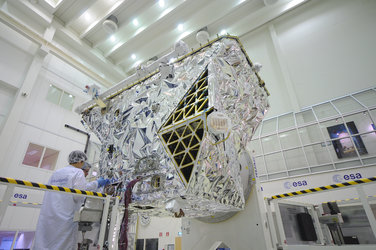The shock of separation
Simulating separation shock
The BepiColombo mission to Mercury has undergone a series of shock tests at ESA’s test facilities to replicate conditions it will experience during its intense ride into space. This video shows tests to mimic the moment it separates from the launch vehicle.
The spacecraft will be connected to the upper stage of an Ariane 5 rocket when it blasts off from Earth in 2015. Once the upper stage and its cargo have reached orbit, the pair will separate.
This is achieved via a pyrotechnic device that will fire open a clamp band, allowing springs to push the spacecraft safely away from the upper stage.
The firing of the pyrotechnic device causes a mechanical shock that transmits through the spacecraft.
To ensure the components of BepiColombo will survive these shocks, and others that occur at fairing opening, rigorous assessments are being carried out at the spacecraft test facilities at ESTEC, ESA’s technical centre in Noordwijk, the Netherlands.
To simulate the launch vehicle separation, the spacecraft structural and thermal test model was suspended from an overhead crane above blocks of foam rubber.
Compressed gas, rather than a pyrotechnic device, opened the clamp and the launch vehicle assembly unit dropped onto the cushioned surface.
At the same time, a number of accelerometers mounted on the spacecraft measured the effect of the shock.
Other mechanical tests to simulate the launch and voyage in space include exposing the spacecraft to the tremendous noise a rocket produces, the harsh vacuum of space, and scorching temperatures of some 450°C that the modules will endure as they orbit around the closest planet to the Sun.
BepiColombo is an international mission between ESA and the Japanese Space Agency, JAXA. It is scheduled for launch in 2015 and will arrive at Mercury in 2022.
The spacecraft comprises two scientific satellites, Japan’s Mercury Magnetospheric Orbiter and Europe’s Mercury Planetary Orbiter.
A third component, the Mercury Transfer Module, will deliver the two satellites into orbit around the planet, where they will study the planet’s composition, geophysics, atmosphere, magnetosphere and geological history.











